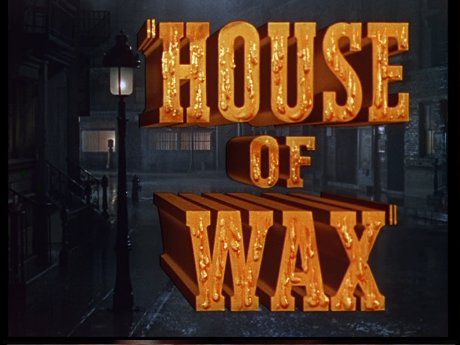Text from this review not to be used without authorization.
Please contact:
Vincent Price gets his first leading horror role in André De Toth's 3-D horror. WB USA R1 DVD.

In the early 1950s, the massive rise of television ownership in the US alarmed film-producers as customers began to stay at home to watch films rather than paying to see them in the cinema. The film studios responded by increasing their output of colour films and developing a variety of widescreen processes to increase the spectacle of the cinema. At the same time, Milton Gunzburg experimented with a process that would allow audiences wearing special glasses to watch a film in 3-D. Unable to find any interest from the Hollywood studios, they used the format to create the independent film Bwana Devil (1952) which despite poor reviews was a huge draw for audiences. The majors quickly took notice and as Columbia rushed into production on a 3-D Noir Man in the Dark (1953), Warner Brothers put together a horror film based on their earlier Mystery of the Wax Museum - itself an experimental film, shot in an early colour process.
Henry Jarrod is a sculptor at a small wax museum in 1900s New York. He models scenes of beauty from around the world and his museum makes a good trade, but not enough for his financial backer Matthew Burke who wants him to open a chamber of horrors. Jarrod is not keen on this so Jarrod, desperate to get his money back, sets fire to the museum for the insurance money - Jarrod tries to stop him but ends up getting left inside the burning building and considered dead. Jarrod survives however and seeks revenge on Burke before opening a new museum but with some exibits that look incredibly like recent murder victims whose bodies have been stolen from morgues...

The script for House of Wax remains very close to the storyline of the 1933 production although the film as a whole looks to emphasise the horror aspects over the mystery storyline of the original (which was really more of a crime picture than a horror film). This means that we get a number of slasher movie style chase sequences and some vivid murders that the original film kept completely off screen. Unfortunately there is not much character development and quite slow pacing throughout, however the film does manage to keep the attention with some very nice set pieces and it all builds to a tense climax if a rather odd epilogue.
With only one eye and unable to see the effects, director André De Toth seemed like a strange choice to helm a 3-D movie, but like all directors in the format he cannot resist adding a number of token shots designed to show off the trickery. Thus we have all sorts of objects thrown or falling towards the camera and although the majority of these are subtle, one sequence stands out as being completely gratuitous as a man bounces a ping-pong ball towards the camera in a quite unnecessarily long sequence. Production values are strong - the wax work museum looks incredibly good and the opening fire sequence is very impressively presented. Composer David Buttolph provides a servicable musical score that does exactly what is expected of it.

Vincent Price takes the top billing here - during the 1940s he had built up something of a reputation for villaineous parts, but this is the first time he would head an all-out horror movie cast. It would be a gruelling filming process, including extensive make-up as the monster along with some very impressive stunts during the opening fire. The film also marks one of the earliest performances of Charles Bronson as a mute sculptor. Phyllis Kirk and Paul Picerni are perfectly solid as the main characters in the storyline, although the limited script doesn't develop them or their relationship particularly.
House of Wax is a perfectly solid horror picture, but never really shines, leaving you with the impression that the film-makers were too focused on the 3-D format to try anything particularly interesting with the storyline or direction. Vincent Price gives a fine performance in the first of what would become a career of heavily made-up horror villain parts. Certainly of interest to Price and classic horror era fans although not the most impressive entry in either oeuvre.

| Anyone famous in it? | Vincent Price - an American horror icon who later appeared in Witchfinder General (1968) Charles Bronson - the future star of the violent vigilante Death Wish (1974) series |
| Directed by anyone interesting? | André De Toth - born in Austria-Hungary, a regular name in the American film circuit in the late 1940s and 1950s, helming a variety of Westerns including Gary Cooper in Springfield Rifle (1952) |
| Any gore or violence ? | None. |
| Any sex or nudity? | None. |
| Who is it for? | Certainly of interest to Price and classic horror fans. |
| Visuals | Original Aspect Ratio - 1.33:1 fullscreen. Colour. The print quality is strong with a lot of detail. As expected for the era, the colour palette is slightly soft, but it is well rendered. |
| Audio | English language original mono sound. Sounds fine. French and Spanish dubbed tracks. |
| Subtitles | English, Bahasa, Chinese, French, Japanese, Korean, Portuguese, Spanish and Thai |
| Extras | The disc includes:
|
| Availability | Only available in a double-bill pack with Mysteries of the Wax Mueseum (1933) on a dual-sided disc. |
| Region | Region 1 (USA, North America) - NTSC |
| Other regions? | A European R2 release includes different language options but is missing the trailer. |
| Cuts? | None known. The print is English language. |